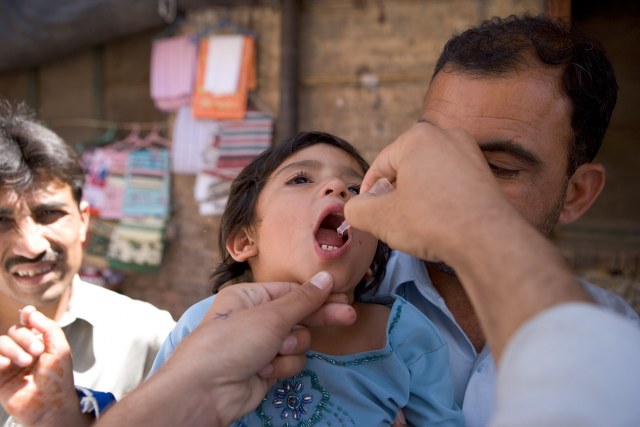 Since the launch of the Global Polio Eradication Initiative in 1988, intense vaccination campaigns have dramatically reduced the number of cases of polio worldwide. Between 1988 and 2000, the number of polio cases dropped 99 percent — from 350,000 to just 3,000.
Since the launch of the Global Polio Eradication Initiative in 1988, intense vaccination campaigns have dramatically reduced the number of cases of polio worldwide. Between 1988 and 2000, the number of polio cases dropped 99 percent — from 350,000 to just 3,000.
But the polio eradication effort appears to have stalled out. Despite an investment of roughly $9 billion and more than two decades of sustained international commitment, polio stubbornly persists. For the past seven years, the number of cases worldwide has hovered between 1,000 and 2,000. The deadline for wiping out the disease has been pushed back again and again. In a New York Times article published in January, Donald McNeil, writes that eliminating the virus is “like trying to squeeze Jell-O to death.” It’s an apt description. “As the vaccination fist closes in one country, the virus bursts out in another,” he continues. Four endemic countries remain—Afghanistan, India, Nigeria, and Pakistan. And the virus has regained a foothold in Angola, Chad, the Democratic Republic of Congo and Sudan.
We have an effective vaccine that provides life-long protection against the virus. So why is this disease so frigging difficult to eradicate?
Part of the problem is biological. Unlike those infected with smallpox, most people infected with the poliovirus do not show signs of infection. For every individual who develops cold or flu-like illness or, in rare cases, permanent paralysis, 19 people are asymptomatic—contagious but not visibly ill. These seemingly healthy people go on vacation or visit relatives, spreading the disease.
Another challenge is logistical. Getting the vaccine—which must be refrigerated—to every child under the age of five in remote and roadless corners of the developing world annually is a daunting task. Children are invariably missed. And the more children who fail to receive the vaccine, the greater the risk of a local epidemic. Local epidemics invariably spread, re-infecting countries once declared free of the disease.
Delivering the vaccine becomes especially difficult in areas of conflict. In 2008, a suicide bomber killed two doctors and a driver who were on their way to distribute the vaccine in Afghanistan. Last year, a Somali polio officer was murdered on his way to supervise National Immunization Days. Another Somali polio officer had to be hospitalized after he was struck by flying mortar fragments in Mogadishu.
Bad press hasn’t helped either. In 2003, Muslim clerics in northern Nigeria urged parents to reject the polio vaccine. The orally administered vaccine drops, they claimed, had been laced by the US—a major sponsor of the eradication initiative—with HIV and anti-fertility drugs. Over the next year, the number of polio cases in Nigeria steadily climbed. Eventually, health officials convinced parents that the clerics’ fears were unwarranted.
But then the eradication initiative faced another setback. The oral vaccine used in developing countries contains a weakened form of live poliovirus. This virus can replicate and spread immunity, which is a good thing. “You get a very impressive herd effect,” Bruce Aylward, head of the eradication initiative, told me in a 2007 interview. “Even if you don’t immunize all the kids in the house, even if you immunize one, usually the other ones who come into contact with that kid are also going to get infected with that live virus vaccine and get protection.” But occasionally the vaccine virus can mutate and regain its ability to cause paralytic polio. That happened in Nigeria in 2006. Between 2006 and 2010, the vaccine-derived virus paralyzed over 200 children.
Setbacks such as these have led some public health experts to question whether eradication is a realistic goal. Perhaps, they argue, we should focus on controlling the disease rather than eliminating it entirely. Proponents counter that giving up now would be a waste of $9 billion.
When I spoke to Aylward in 2007, he said the polio eradication effort is a “high stakes” endeavor. “If you’re successful, and all the pieces fall into place and the stars line up, you have a perpetual gift to future generations of a polio-free world.” What a gift that would be.
**
Image credit: Global Polio Eradication Initiative
I remember the fear of getting polio when I was a child (in the U.S.). Everyone knew someone who had polio. I remember our family doctor coming to our house to administer polio vaccine. This was before a large eradication campaign, I remember a long line of people outside our church one Sunday, receiving the oral vaccine. Thankfully the fear of polio was not an issue for my kids. Global eradication would indeed be a gift to the world. Your post reminds me to support Rotary International’s efforts in this regard.
One of my friends claims to be the last polio victim in the US. I hope so. I wouldn’t wish it on anyone.
Presumably, vaccinated carriers would become non-carriers.